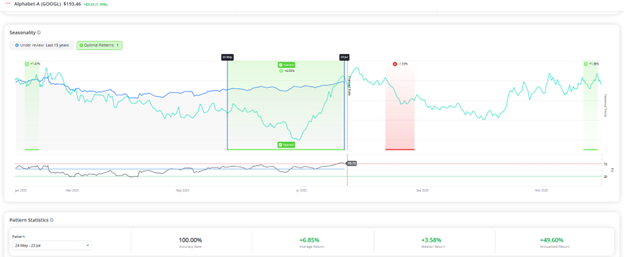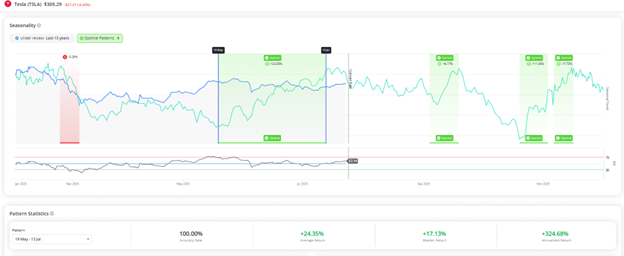Alphabet and Tesla's Earnings Are In – This Tool Reveals Whether They're Buys Now VIEW IN BROWSER It’s the most wonderful time of year, folks. I’m not talking about Christmas – or even Christmas in July. I’m talking about earnings season. Lucky for us, we get to celebrate it four times a year. If you’re one of my paid subscribers, you know this is what we live and die for. Earnings season is when markets act rationally. Companies with rock-solid fundamentals, growing sales and rising earnings get rewarded. Those that don't – well, they get punished. Thankfully, across my premium services, we’re positioned in fundamentally superior names, backed by strong institutional buying pressure. While we don’t bat a thousand, this is typically when our stocks shine brightest. But this earnings season, investors want more than just a beat. They want clear leadership. And who better to provide that than one of the Magnificent Seven stocks? In fact, we got a look at two of them after the market closed on Wednesday: Alphabet, Inc. (GOOGL) and Tesla, Inc. (TSLA). Heading into these earnings reports, investors were anxious. Where does Alphabet stand in the AI race compared to its other Big Tech counterparts? Would Tesla’s Robotaxi show signs of finally delivering on Elon Musk’s lofty promises? More importantly, were they able to deliver the leadership that the market craves? We’ll answer that by breaking down Alphabet’s and Tesla’s earnings in today’s Market 360. Then, we’ll leverage the powerful seasonality tool I’ve been telling you about from my friends at TradeSmith to see whether you should buy them. | Recommended Link | | | | Futurist Eric Fry say Amazon, Tesla and Nvidia are all on the verge of major disruption. To help protect anyone with money invested in them, he’s sharing three exciting stocks to replace them with. He gives away the names and tickers completely free in his brand-new “Sell This, Buy That” broadcast. Click to stream now… |  | | Alphabet, Inc. Going into its earnings report, Wall Street was wondering if ongoing antitrust challenges and intense AI competition would finally catch up to the search giant. Well, Alphabet delivered, at least on the headline numbers. The company posted adjusted earnings per share of $2.31, topping analyst forecasts of $2.18 per share. Revenue came in at $96.43 billion, beating Wall Street’s expectation of $94 billion. That represents an impressive 14% year-over-year jump. Alphabet’s individual segments also showed strength. For example, YouTube ad revenue was $9.8 billion, above the forecasted $9.56 billion. But the real story here is Alphabet’s aggressive push into AI. For starters, the Google Cloud segment brought in $13.62 billion versus estimates of $13.11 billion – and increased by 32%. The division has signed more billion-dollar deals in the first half of 2025 than it did in all of 2024 – and it now has a backlog of $106 billion. I should also add that Gemini, the company’s flagship AI platform, now has over 450 million users, with requests up by more than 50% since Q1. Meanwhile, Google’s AI video generator (Veo3) has already generated 70 million videos in just two months. What Alphabet is doing in AI right now is just stunning. So it should come as no surprise, then, that Alphabet is increasing its AI spending to a staggering $85 billion, up from an earlier projection of $75 billion. Alphabet clearly intends to take the fight directly to competitors like Microsoft Corporation (MSFT) in the rapidly growing AI market. Yet, despite the strong beat on earnings and revenue, shares initially pulled back after hearing the AI spending news. But remember, I said this is the rational time of year. That turned out to be true in this case, as the stock snapped back once investors realized that you have to spend money to make money – and so far, the company’s AI best are paying off. Tesla, Inc. Then there is Tesla. Investors entered this earnings call worried. With declining auto revenues, falling vehicle deliveries and a significant reduction in regulatory EV tax credits, the stakes were high. I won’t even get into the fact that investors are eternally worried about CEO Elon Musk, his ongoing shenanigans and whether worries about reputational risk will finally catch up to the company. Unfortunately, Tesla didn’t do much to calm these fears. Adjusted earnings per share came in at $0.40, and revenue dropped 12% year-over-year to $22.5 billion. Earnings narrowly met expectations, but revenue fell short of analysts’ forecast of $22.64 billion. Digging deeper, auto sales fell for the second quarter in a row, dropping 16% from last year to $16.7 billion. Vehicle deliveries also slipped 14% year-over-year to 384,000 units. Tesla's revenue from selling regulatory credits fell from $890 million a year ago to $439 million. And on the earnings call, CEO Elon Musk openly warned investors that losing regulatory credits, part of President Trump’s recent policy changes, could mean Tesla faces “a few rough quarters” ahead. Tesla didn’t provide any official guidance, and the stock fell 8% on Thursday in the wake of the results. But the company did offer some hope to investors. Tesla said it started producing a more affordable car model in June, with mass production planned for the second half of 2025. The company also said its robotaxi will continue rolling out for testing in cities across the country and is still scheduled for mass production in 2026. Are Alphabet and Tesla Buys? Now, after looking at these results, it’s obvious that Alphabet showed a bit more leadership than Tesla. So, you’re probably thinking Alphabet is the better buy, right? But here’s the real question: Is it actually the right time to buy? To answer that question, I turned to the new seasonality tool offered by my friends over at TradeSmith. In short, it’s a clever way to spot which stocks have a history of soaring on particular calendar dates – based on the trading history of more than 5,000 stocks. They call it the “Green Day” system – and so far, the results are fantastic, with 83% accuracy in backtesting. So, let’s take a look at Alphabet’s chart. You can see that it just exited a zone of “green days” from May 24 to July 23, where it delivered an average gain of 6.85% - and with a 100% accuracy rate.  In fact, GOOGL is about to enter a seasonal period where it declines. You can see that in the red zone above. The next “green day” isn’t until December. Now let’s take a look at Tesla’s chart. As you can see, it just exited a wide zone of “green days” where the average return was 24.35% - with a 100% accuracy rate.  Now, there are a few more “green days” ahead for Tesla, but none of them are as powerful as the one we just exited. The next one is coming up in September. But if you’re a trader looking for opportunities for powerful gains, then you may want to learn more about this tool and put TSLA on your watchlist. How to Put This Tool to Work for You If you’ve followed along lately, you know I’ve been talking about TradeSmith’s seasonality tool for the past couple of weeks. Now, I can show you all kinds of interesting screenshots. But the truth is, it’s easier to get a sense of how powerful this tool is when you see it in action for yourself. Look, I’ve been making models that beat the market since the 1970s. That’s why I was once called the “King of Quants” before most people knew what that even was. These days, though, thanks to the power of technology and innovation, there are countless systems and tools out there. But I have to say, TradeSmith’s seasonality tool is unlike anything I’ve encountered in my 50-year career. So, I encourage you to see what this game-changing tool can do by clicking here now. Sincerely, |
0 Response to "Must Read: Alphabet and Tesla’s Earnings Are In – This Tool Reveals Whether They’re Buys Now"
Post a Comment